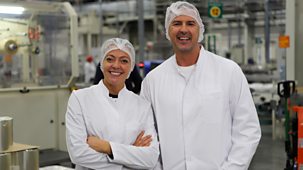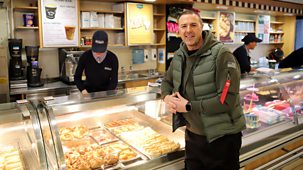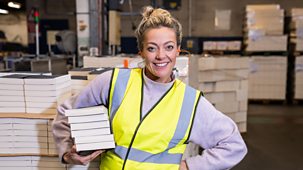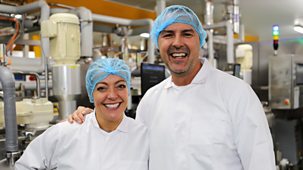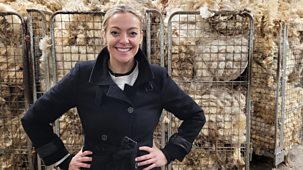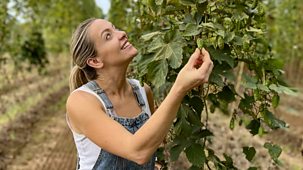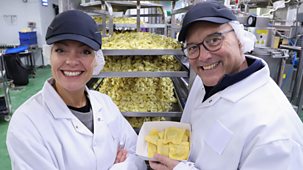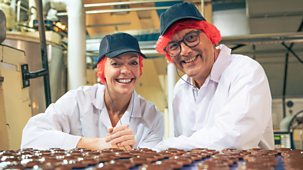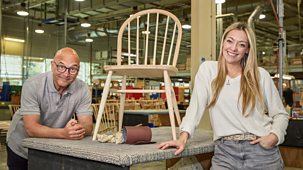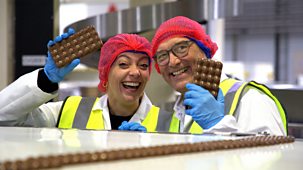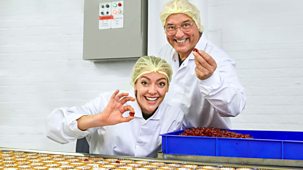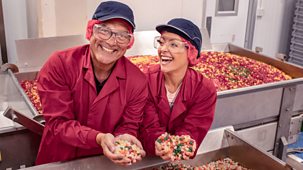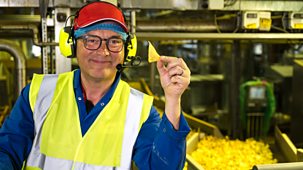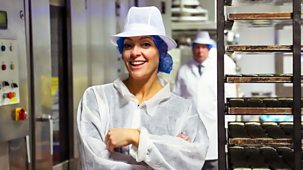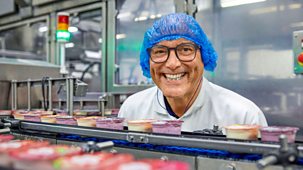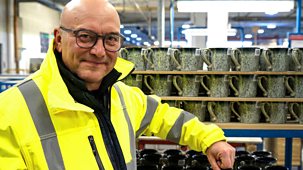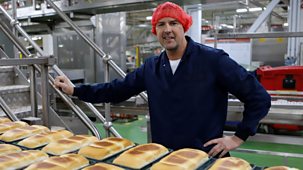
Series 9: 2. Sliced Bread
In a nostalgic episode of Inside the Factory, new presenter Paddy McGuinness visits the Warburtons bread factory in his hometown of Bolton, where he once worked as a youngster more than 30 years ago. At Warbies, as the locals call it, he catches up with old friends and learns how the machines, ovens and conveyors he once cleaned enable the site to produce 1.4 million loaves of bread every week.\n\nAs a fitting return to the factory, Paddy makes a grand entrance by driving a tanker of flour through the gates. As he manoevres his way to the intake area, he reveals that he was a young boy of sixteen when he worked here - it was a Saturday job, cleaning out the massive bread-making machines. However, the machines didn't run on Saturdays, which means that he’s going to see them in action for the first time! With a little trepidation, Paddy dons the obligatory hairnet and steps inside the factory to soak up the memories. But he can’t hang around reminiscing - there’s sliced white bread to be made.\n\nSo, he heads back outside to where he left his tanker full of flour. Head of Flour Stuart Jones tells him that they receive three tanker loads each day, containing a total of 90 tonnes – enough to make 170,000 loaves of bread. As the mix of British and Canadian flour is unloaded, Paddy heads back inside the factory, where he spots a familiar face - his old school friend Pete, who got him the Saturday job and still works at the factory.\n\nAfter a quick chinwag, Paddy heads to the dough-mixing area to meet someone with a very impressive title: Unbeatable Quality Manager, Rachel Bacon. Rachel tells Paddy that the key to making the best white bread is air bubbles; inside each slice there are 13,000 bubbles, which are all counted by computer. To make the dough, a mixer combines the flour with water and brine, along with yeast and a special ingredient called improver, which helps with the structure of the dough.\n\nAfter mixing for three minutes, the dough is tipped out and chopped into 341 separate pieces, each one weighing 920 grams. Every one of these mounds of dough will go on to make a loaf. The dough travels through a machine, which relaxes the strands of gluten inside and allows them to fully form, holding in the thousands of bubbles.\n\nNext, the dough is flattened and rolled out again - a bit like a Swiss roll. Then it’s chopped into four, turned 90 degrees and squashed together again. This method is called cross panning and gives extra strength to the finished loaves. Paddy and Rachel agree that it’s an important process, as it means that when you have a chip butty and want to roll the bread around the chips, it won’t break.\n\nPaddy’s dough drops into tins and travels towards a huge machine called a prover, where Paddy meets another expert, Manufacturing Excellence Manager Joanna Whitehurst. This massive, warm room is kept at between 37 and 40 degrees Celsius, which is the perfect temperature for the yeast inside the dough to activate and feed on naturally occurring sugars - a process called fermentation. This releases carbon dioxide gas, causing the bubbles in the dough to expand and the loaves to rise. Once risen, a lid is placed on top of every tray, which gives the loaves a distinctive flat top.\n\nAfter two hours and forty minutes in production, the tins go into the 32-metre-long oven. Paddy tells Joanna that when he worked at the factory, he used to clean the ovens - and they were spotless! Twenty-one minutes after entering the oven, the bread is turned out of the tins, and the golden loaves stream along the conveyor for Paddy to see and smell them in all their glory.\n\nThey are making sliced bread, so the slicing machine creates 17 slices for every loaf, each one is 13.7 millimetres thick. Finally, they are wrapped in traditional-style waxed paper, which helps to lock in the freshness. Paddy remembers his mother using the distinctive paper to wrap his sandwiches for school.\n\nAs he heads to dispatch, Paddy bumps into his old mate Pete again. They reminisce about the old days at the bread factory. Paddy remembers not being able to get out of bed in the morning but having to walk to the factory in the cold and rain, ready to start his shift at 6.00am. Paddy watches as 6,000 loaves are loaded into the back of a lorry; the factory dispatches 44 wagons every day.\n\nWith the soundtrack of M People’s 90s anthem Moving on Up blasting out, Paddy loads the final trolley of sliced white bread into the lorry. Elsewhere in the episode, Cherry Healey visits the Dualit factory to learn how they make toasters and visits a brewery turning waste bread into pints of beer, while historian Ruth Goodman discovers why white bread was banned during the Second World War.
Source: BBC 2
Most recent episodes of Inside the Factory
Inside The Factory
Series 9: 1. Chocolate Seashells
Paddy McGuinness is fully immersing himself in the festive spirit as he explores a huge chocolate factory in Belgium. With lots of taste tests to enjoy along the way, he embrace ...
13-12-2025
BBC 2
Inside The Factory
Series 9: 6. Sausage Rolls
Paddy McGuinness explores the secrets of the McColgan’s bakery in Strabane, Northern Ireland, to reveal how it makes more than half a million sausage rolls a day. \n\nAft ...
09-02-2025
BBC 2
Inside The Factory
Series 9: 5. Hardback Books
Paddy McGuinness visits the Clays book factory in Suffolk to learn how they produce 20,000 copies of Pride and Prejudice for publisher Penguin. The factory makes an astonishing ...
02-02-2025
BBC 2
Inside The Factory
Series 9: 4. Flapjacks
In this episode, Paddy McGuinness explores the secrets of the Graze factory in west London, revealing how they make 40 million flapjacks a year. \n\nArmed with a trusty tasting ...
26-01-2025
BBC 2
Inside The Factory
Series 9: 3. Cheese Curls
In this episode, Paddy McGuinness explores the secrets of the Walkers factory in Lincoln, to reveal how it makes 500 million packs of Quavers every year. \n\nPaddy begins by mee ...
19-01-2025
BBC 2
Inside The Factory
Series 9: 2. Sliced Bread
In a nostalgic episode of Inside the Factory, new presenter Paddy McGuinness visits the Warburtons bread factory in his hometown of Bolton, where he once worked as a youngster m ...
12-01-2025
BBC 2
Inside The Factory
Series 8: 7. Carpets
Gregg Wallace explores the Axminster factory in Devon to reveal how it produces 46,000 square metres of carpet every year. He follows the production of one of their best sellers ...
15-11-2024
BBC 2
Inside The Factory
Series 8: 6. Bath Bombs
Gregg Wallace visits the colourful and fragrant Lush factory in Dorset to learn how an astonishing 14 million bath bombs are produced every year.\n\nCherry Healey visits Loughbo ...
09-10-2024
BBC 2
Inside The Factory
Series 8: 5. Stout
Gregg Wallace explores the secrets of the Guinness brewery in Dublin to reveal how it makes two million litres of Irish stout every single day.\n\nCherry Healey visits a water t ...
02-10-2024
BBC 2
Inside The Factory
Series 8: 4. Stuffed Pasta
Gregg Wallace explores the Dell Ugo factory in Hertfordshire to reveal how it makes 500 million stuffed pasta parcels every year. \n\nHe’s following production of one of ...
25-09-2024
BBC 2
Most popular episodes of Inside the Factory
Inside The Factory
Series 7: Jaffa Cakes
Gregg Wallace visits a Manchester factory that churns out 6 million Jaffa Cakes every single day - 1.4 billion per year. Cherry Healey is in Jaffa, the city responsible for grow ...
26-06-2024
BBC 2
Inside The Factory
Series 6: 5. Chairs
Gregg Wallace visits the Ercol factory in Buckinghamshire, an area associated with furniture making since the 19th century.\n\nWe Brits spend a staggering £300 million pou ...
15-02-2023
BBC 2
Inside The Factory
Series 8: 8. Chocolate Bars
Gregg Wallace is in the UK’s city of chocolate, York, exploring how the Nestle factory makes more than eight million bars of chocolate every day. The bar he’s follow ...
01-03-2024
BBC 2
Inside The Factory
Series 5: 1. Cherry Bakewells
Gregg Wallace is in Stoke-on-Trent at an enormous cherry bakewell factory where they produce 250,000 little tarts every day. He follows the production of cherry bakewells, from ...
03-08-2023
BBC 2
Inside The Factory
Series 8: 2. Jelly Beans
Gregg Wallace explores the Jelly Bean Factory in Dublin to reveal the incredible processes it employs to make ten million colourful little sweets every day.\n\nCherry Healey vis ...
05-09-2024
BBC 2
Inside The Factory
Series 6: Tortilla Chips
Gregg Wallace visits the biggest tortilla factory in Europe. The Coventry site covers more than 21,000 square meters, the size of three football pitches, and makes 60,000 tonnes ...
21-06-2023
BBC 2
Inside The Factory
Series 6: Ice Cream
Gregg Wallace visits a family-run factory in the heart of rural Aberdeenshire, which churns out more than 49 tonnes of dairy ice cream every day. Gregg is delighted to learn he& ...
21-05-2023
BBC 2
Inside The Factory
Series 7: Crumpets
Gregg Wallace visits the factory making 432 million crumpets every year. Crumpets are a British classic made from a precise combination of ingredients, using some clever chemist ...
24-07-2024
BBC 2
Inside The Factory
Series 6: 3. Yogurt
We eat them for breakfast, pack them in our lunch boxes and enjoy them for dessert; here in the UK we spend £1.4 billion a year on yogurt pots. Gregg Wallace visits a fact ...
09-02-2023
BBC 2
Inside The Factory
Series 6: Mugs
Gregg Wallace visits the Denby factory in Derbyshire, which has been making pottery since 1809. We Brits drink a staggering 195 million mugs of tea and coffee every day, so Greg ...
16-05-2023
BBC 2


